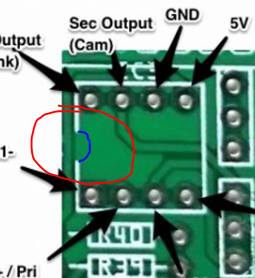It may surprise you to know that many public libraries have links to eResources or databases to help people find information. 😀 This includes information about how to repair cars. My local library has a link to MEL (Michigan Electronic Library) who kindly pays for online repair guides for virtually every car. These repair guides include wiring diagrams for the cars. I recently talked to a guy in Canada and he was excited to find that the information was available through his library as well. Many of you will ask “where’s the link”. Unfortunately because the information requires payment on some level, most of the time your IP address will have to match the region where the information is being made available from. For example the guy mentioned above tried to use the one from Michigan, but it would not let him gain access.
Author: Weaver
Line Up Your Conditioner
No matter the conditioner the pin outline should be facing UP, and the gaps in the white marking, or sometimes it’s a half-moon, should line up. See pic.

SpeedyLoader
Josh, captain of the star ship Speeduino, has divined a cool new gadget called SpeedyLoader. It’s purpose, to make getting your Speeduino firmware loaded faster and easier than ever. So, when your package arrives in the mail, give it a try. You can find the latest release HERE. Windows PC users download the file ending with EXE, Mac users the DMG file, and Linux the APPIMAGE file.
A Few Words About MAP
I think it’s important to start at the beginning. There is about 100kPa of atmospheric pressure resting on us all the time. I think this is why I find it difficult to get out of bed in the morning. Due to this constant pressure any MAP sensor has to be able to read at least that much absolute pressure. Oh hello MPX4115AP, this is one of NXP’s 4000 series pressure sensors. The A means it measures absolute pressure, the P tells us that it has a port on it so we can attach a hose. Now for the really important part, 115 tells us that it can measure 115kPa, hmm that would be perfect for a non-boosted engine. Actually it reads from 15-115kPa and over that range outputs a linear analog signal from almost 0v to almost 5v. This is important as that means that it has a sensitivity of 46mV/kPa and it’s the sort of signal an Arduino can read.
So you have boost or think you’ll have boost in the future? No problem the most commonly used sensor is the MPX4250AP. It can read 20-250kPa of absolute pressure, and if you figure the atmosphere’s pressure maxes out at 110kPa, you are left with 140kPa of boost. That translates into 20PSI, in case you don’t feel like Googling that. Have even more boost?? Guess what? There is also an MPX4400AP that measures 20-400kPa that would allow 290kPa or 42PSI of boost!
So why not just use the 400kPa sensor all the time? Well three reasons come to mind. The first is availability, they are nearing the end of their lifecycle and are only stocked by a few distributors. Second, that first issue makes them cost more. Third an possibly most important is sensitivity. Because all the sensors work over a similar voltage range, whenever you widen the pressure range you decrease the sensitivity. Sensitivity for the 3 sensors are as follows: 115kPa=46mV/kPa, 250kPa=20mV/kPa, 400kPa=12mV/kPa.
Now with all that said it appears that the Arduino MEGA can handle 5mV increments. However if the sensitivity was 5mV/kPa then you would only be able to sense pressure in whole numbers, no fractions. Is that a problem? ¯\_(ツ)_/¯ The MPX4250AP offers the best compromise though. It’s the cheapest, most available variant, has decent sensitivity, and can handle a fair amount of boost.
-turboedge
